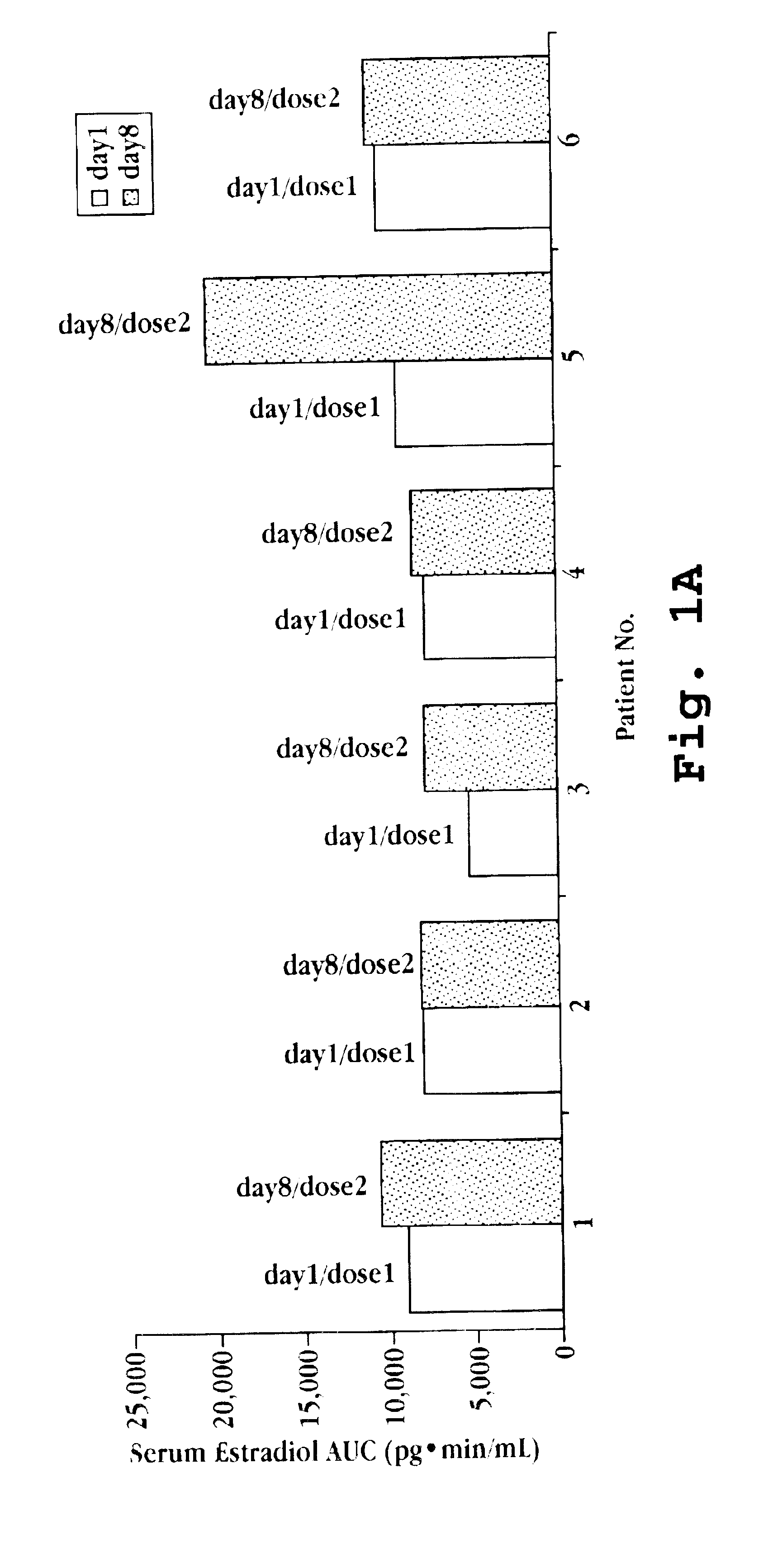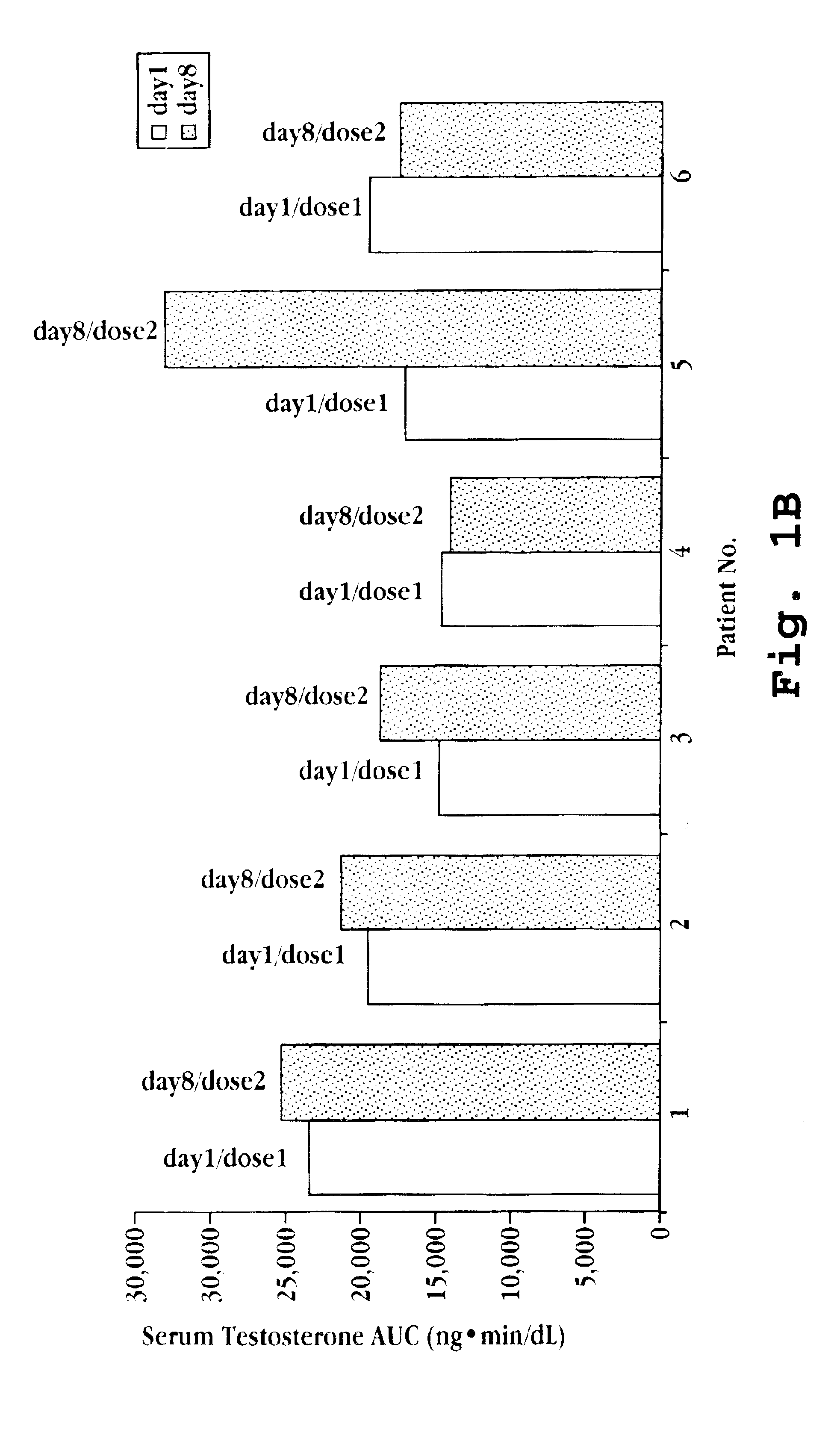Methods and compositions for treating benign gynecological disorders
a gynecological disorder and benign technology, applied in the field of benign gynecological disorders and to a contraceptive method, can solve the problems of excessive menstrual bleeding or significant pelvic pain, interfere with work or usual social activities or relationships, and often so severe symptoms, so as to prevent endometrial hyperplasia, prevent endometrial hyperplasia, and prevent endometrial hyperplasia
- Summary
- Abstract
- Description
- Claims
- Application Information
AI Technical Summary
Benefits of technology
Problems solved by technology
Method used
Image
Examples
example 1
Preparation of Intranasal Formulation
[0098]2-Hydroxypropyl-β-cyclodextrin was added to water at a concentration of 240 mg / mL and stirred until dissolved. 17β-Estradiol was then added to the water-cyclodextrin solution at a concentration of 1.0 mg / mL. The mixture was stirred until dissolution. Testosterone at a concentration of 5.0 mg / mL was then added, and after stirring to dissolution benzalkonium chloride (0.1 mg / mL), ethylene diamine tetra acetic acid (EDTA;1 mg / mL), and sorbitol (61.6 mg / mL) were added. The mixture was stirred. Then, the GnRH compound deslorelin acetate was added at a concentration of 20 mg / mL with stirring. The volume was brought to the final desired volume and the pH was adjusted as needed. Table 2 summarizes the preparation components, concentrations, and dosages per 50 μL.
[0099]
TABLE 2Components in Exemplary Nasal PreparationConcentrationComponent(mg / mL)Dose per 50 μLdeslorelin acetate201.0mgestradiol1.050μgtestosterone5.0250μghydroxypropyl β cyclodextrin240...
example 2
Intranasal Administration of Deslorelin to Premenopausal Women with Uterine Leiomyomata
[0100]A 12 week study was performed to establish an effective dose of deslorelin for controlling heavy bleeding secondary to uterine leiomyomata. Forty-one women completed the study and are identified as Subject Nos. 1-41. The women were divided into test groups for treatment with intranasal deslorelin as follows:
[0101]
Group 1Subject Nos. 1-6placebo, 0 mg deslorelinGroup 2Subject Nos. 7-210.5 mg deslorelin, once per dayGroup 3Subject Nos. 22-341.0 mg deslorelin, once per dayGroup 4Subject Nos. 35-412.0 mg deslorelin, once per day
[0102]An intranasal preparation consisting of deslorelin at the indicated concentration along with sorbitol (61.6 mg / mL), benzalkonium chloride (0.1 mg / mL), and water was prepared according to the procedure of Example 1. The preparation was administered with a commercially available nasal sprayer that delivered a 50 μL spray volume. The preparation was administered by appl...
example 3
Intranasal Administration of a GnRH compound, an Estrogen, and an Androgen to Oophorectomized Women
[0108]Six volunteer women with prior oophorectomies and not presently on hormone replacement therapy were recruited. Each woman was treated with 50 μL of a nasal spray preparation, prepared as described in Example 1, on two occasions separated by one week. The 50 μL dose delivered 1 mg deslorelin, 50 μg 17β-estradiol, and 250 μg testosterone. Blood samples were collected 20 minutes and 10 minutes prior to dosing on day 1 and on day 8, and then at the following intervals after dosing on each day: 10, 20, 30, 40, 60, 90, 120, 180, 240, 360, 1440 minutes. Serum estradiol and testosterone levels were determined from the samples, and the baseline corrected cumulative area under the curve from 0 to 360 minutes for each patient for each dose are presented in FIGS. 1A and 1B.
PUM
| Property | Measurement | Unit |
|---|---|---|
| volume | aaaaa | aaaaa |
| volume | aaaaa | aaaaa |
| time | aaaaa | aaaaa |
Abstract
Description
Claims
Application Information
 Login to View More
Login to View More - R&D
- Intellectual Property
- Life Sciences
- Materials
- Tech Scout
- Unparalleled Data Quality
- Higher Quality Content
- 60% Fewer Hallucinations
Browse by: Latest US Patents, China's latest patents, Technical Efficacy Thesaurus, Application Domain, Technology Topic, Popular Technical Reports.
© 2025 PatSnap. All rights reserved.Legal|Privacy policy|Modern Slavery Act Transparency Statement|Sitemap|About US| Contact US: help@patsnap.com


